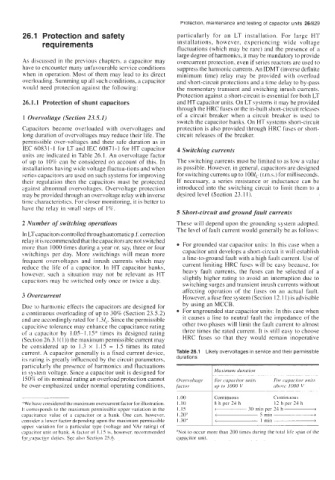Page 877 - Industrial Power Engineering and Applications Handbook
P. 877
Protection, maintenance and testing of capacitor units 26/829
26.1 Protection and safety particularly for an LT installation. For large HT
requirements installations, however, experiencing wide voltage
fluctuations (which may be rare) and the presence of a
large degree of harmonics, it may be mandatory to provide
As discussed in the previous chapters, a capacitor may overcurrent protection, even if series reactors are used to
have to encounter many unfavourable service conditions suppress the harmonic currents. An IDMT (inverse definite
when in operation. Most of them may lead to its direct minimum time) relay may be provided with overload
overloading. Summing up all such conditions, a capacitor and short-circuit protections and a time delay to by-pass
would need protection against the following: the momentary transient and switching inrush currents.
Protection against a short-circuit is essential for both LT
26.1.1 Protection of shunt capacitors and HT capacitor units. On LT systems it may be provided
through the HRC fuses or the in-built short-circuit releases
1 Overvoltage (Section 23.5.1) of a circuit breaker when a circuit breaker is used to
switch the capacitor banks. On HT systems short-circuit
Capacitors become overloaded with overvoltages and protection is also provided through HRC fuses or short-
long duration of overvoltages may reduce their life. The circuit releases of the breaker.
permissible over-voltages and their safe duration as in
IEC 6083 I - 1 for LT and IEC 6087 1 -I for HT capacitor 4 Switching currents
units are indicated in Table 26.1. An overvoltage factor
of up to 10% can be considered on account of this. In The switching currents must be limited to as low a value
installations having wide voltage fluctua-tions and when as possible. However, in general, capacitors are designed
beries capacitors are used on such systems for improving for switching currents up to 100Zc (r.m.5.) for milliseconds.
their regulation then the capacitors must be protected If necessary, a series resistance or inductance can be
against abnormal overvoltages. Overvoltage protection introduced into the switching circuit to limit them to a
may be provided through an overvoltage relay with inverse desired level (Section 23.1 I).
time characteristics. For closer monitoring, it is better to
have the relay in small steps of 1%.
5 Short-circuit and ground fault currents
2 Number of switching operations These will depend upon the grounding system adopted.
The level of fault current would generally he as follows:
In LTcapacitors controlled through aut0maticp.f. correction
relay it is recommended that the capacitors are not switched For grounded star capacitor units: In this case when a
more than 1000 times during a year or, say, three or four
switchings per day. More switchings will mean more capacitor unit develops a short-circuit it will establish
frequent overvoltages and inrush currents which may a line-to-ground fault with a high fault current. Use of
reduce the life of a capacitor. In HT capacitor banks, current limiting HRC fuses will be easy because, for
however, such a situation may not be relevant as HT heavy fault currents, the fuses can be selected of a
capacitors may be switched only once or twice a day. slightly higher rating to avoid an interruption due to
switching surges and transient inrush currents without
affecting operation of the fuses on an actual fault.
3 Overcurrent However, a fuse free system (Section 12.1 1) is advisable
Due to harmonic effects the capacitors are designed for by using an MCCB.
a continuous overloading of up to 30% (Section 23.5.2) For ungrounded star capacitor units: In this case when
and are accordingly rated for 1.31,. Since the permissible it causes a line to neutral fault the impedance of the
capacitive tolerance may enhance the capacitance rating other two phases will limit the fault current to almost
of a capacitor by 1.05-1.15* times its designed rating three times the rated current. It is still easy to choose
(Section 26.3.1 (1)) the maximum permissible current may HRC fuses so that they would remain inoperative
be considered up to 1.3 x 1.15 = 1.5 times its rated
current. A capacitor generally is a fixed current device, Table 26.1 Likely overvoltages in service and their permissible
its rating is greatly influenced by the circuit parameters, durations
particularly the presence of harmonics and fluctuations
in system voltage. Since a capacitor unit is designed for Maximum durcitiun
~~
150% of its nominal rating an overload protection cannot ~~ ~~~~~ ~~~ ~ ~- ~~ ~ ~ ~ For capacitor iinits ~
~~
~
~
he over-emphasized under normal operating conditions, factor up to I000 v ribow 1000 V
I .oo
Continuous
Continuous
8 h per 24 h
12 h per 24 h
1.10
"We have considered the maximum overcurrent factor for illustration. 1.15 - 30 rnin per 24 h -
It corresponds to the maximum permissible upper variation in the
capacitance value of a capacitor or a bank. One can, however, I .20" < 5 min 3
consider a lower factor depending upon the maximum permissible 1.30" I < 1 min >
upper variation for a particular type (voltage and VAr rating) of
capacitor unit or bank. A factor of I .I5 is, however, recommended "Not to occur more than 200 times during the total life span of the
for capacitor duties. See also Section 25.6. capacitor unit.

